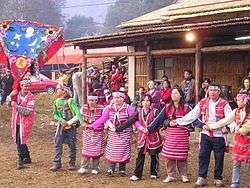Saisiyat people
The Saisiyat (Chinese: 賽夏; pinyin: Sàixià; Wade–Giles: Sai4 Hsia4; "true people"), also spelled Saisiat, are an indigenous people of Taiwan. In 2000 the Saisiyat numbered 5,311, which was approximately 1.3% of Taiwan's total indigenous population,[1] making them one of the smallest aboriginal groups in that country. The Saisiyat inhabit Western Taiwan, overlapping the border between Hsinchu County and Miaoli County. They are divided into the Northern Branch (Wufong in the mountainous Hsinchu area) and the Southern Branch (Nanzhuang and Shitan in the highlands of Miaoli), each with its own dialect. Their language is also known as Saisiyat.
 Pas-ta'ai ceremonies in Nanzhuang, Miaoli, Taiwan | |
| Total population | |
|---|---|
| 6,743 (2020) | |
| Regions with significant populations | |
| Taiwan | |
| Languages | |
| Saisiyat, Mandarin Chinese | |
| Religion | |
| Animism, Christianity | |
| Related ethnic groups | |
| Taiwanese Aborigines |
Names
Saisiyat are sometimes rendered as Saiset, Seisirat, Saisett, Saisiat, Saisiett, Saisirat, Saisyet, Saisyett, Amutoura, or Bouiok.
Culture
The Saisiyat people hold a festival called Pasta’ay every two years.[2]
Saisiat Global Flood Account In the ancient times, human beings were created by god and lived in the original land. Then a flood happened suddenly and human beings were dispersed everywhere without knowing what would happen. Then, a man sat on a weaving loom and floated to Airubia Mountain. There was a god called Otspoehobong (Oopenhaboon) on the mountains. The god grabbed the man suddenly. Fearing that the flood would cause human beings to be extinct, the god killed the survivor, pounded his flesh, chanted an incantation, and threw the flesh of the dismembered corpse into the sea. The flesh turned into human beings. They were our ancestors named Siasiat by the god. Then the god cut his intestines and threw into the sea. The intestines turned into human beings. They were the ancestors, of Taiwanese… Then it threw his bones into the sea. The bones also turned into human beings. They were ancestors of the indomitable Atayal people.
References
- Directorate General of Budget, Accounting and Statistics, Executive Yuan, R.O.C. (DGBAS). National Statistics, Republic of China (Taiwan). Preliminary statistical analysis report of 2000 Population and Housing Census Archived 2007-03-12 at the Wayback Machine Excerpted from Table 28:Indigenous population distribution in Taiwan-Fukien Area. Accessed PM 8/30/06
- Han Cheung (18 November 2018). "Taiwan in Time: Losing, keeping and reviving the faith". Taipei Times. Retrieved 18 November 2018.